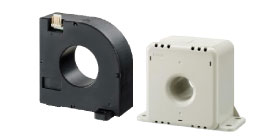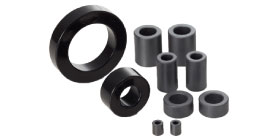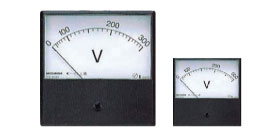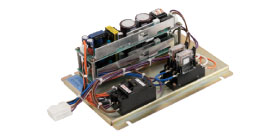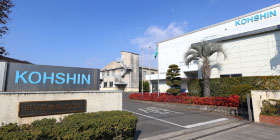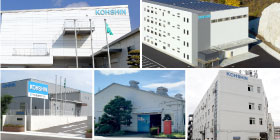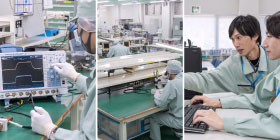Categories
- Product Purchasing
- Product Applications and Record of Performance
- Customization
- Characteristics & Others
- About Standard Current Sensors for Automotive Applications
- About Quality Assurance
- About Certification
- About Precautions for Use
Product Purchasing
- How can I purchase your products?Please contact us by e-mail or phone.
Our staff will contact you after confirming the details of your inquiry. - Is there a minimum purchasing unit of lots?There is no minimum purchasing unit. You can even order one unit.
- How long does it take to deliver the product?It varies depending on the model, quantity and other conditions. For details, please contact us by e-mail or phone.
- How are products packed during delivery?As a general rule, we use a cardboard box for packaging our products with some exceptions. For details, please contact us by e-mail or phone.
- How can I get a price quote?First, please contact us by e-mail or phone. As we basically conduct business via distributors, we will introduce you to a distributor based on the details such as model, quantity, application, etc.
- What does the product model indicate?Please refer to “User’s Guide: Product Labeling.”
- What does the product lot number indicate?Please refer to “User’s Guide: Product Labeling.”
- What approach should I take in selecting a product?Take into consideration the current sensor’s mounting method, rated current, detection accuracy, control power supply, etc., when selecting a product. However, it depends on the customer’s application and operating environment, so please contact us by e-mail or phone for more details.
- How can I get a sample for evaluation?Please contact us by e-mail or phone.
Our staff will contact you after confirming the details of your inquiry. - How long does it take to deliver samples for evaluation?It varies depending on the model, quantity and other conditions. For details, please contact us by e-mail or phone.
Product Applications and Record of Performance
- What applications are current sensors used for?Applications are broadly classified into industrial and automotive. Industrial applications include general-purpose inverters, servos, NC machine tools, UPS units, solar power generation, and fuel cells, while automotive applications include electric vehicles such as EVs and HEVs.
- Is it possible to use current sensors for automotive applications (running, turning, stopping)?It is possible if you select an automotive current sensor.
- Is it possible to use current sensors for medical equipment and other life-support applications?As long as an appropriate model is selected, it is possible to use current sensors for medical equipment such as MRI. However, please consult with us or our distributor in advance for applications that require a particularly high level of quality and reliability, such as life-support medical equipment and various safety devices.
Customization
- Is it possible for your company to meet specifications not listed in the catalog (e.g., changes in rated current, etc.)?It may be possible. Please contact us by e-mail or phone. Our staff will contact you after confirming the details of your inquiry.
- In such a case, what will be the development costs and lead time?They vary depending on the model, quantity and other conditions. For details, please contact us by e-mail or phone.
- Is it possible for your company to handle fully customized product development?It may be possible. Please contact us by e-mail or phone. Our staff will contact you after confirming the details of your inquiry.
- In such a case, what will be the development costs and lead time?In the case of full customization, development costs such as costs of dedicated molds and a certain development period are required. For details, please contact us by e-mail or phone.
Characteristics & Others
- What is the operating principle of current sensors?Our current sensors are available in open-loop type, closed-loop type, and fluxgate type. Please refer to “Description of Methods” for the operating principle and features of each type.
- What is the definition of characteristics?The definition of characteristics of current sensos is explained in “Description of Characteristics.”
For more detailed explanations of the following characteristics, please refer to Email Newsletters.Description of Characteristics
・Rated Current/Rated Output: Email Newsletters (PDF available in Japanese Only)
・Residual Output: Email Newsletters (PDF available in Japanese Only)
・Linearity: Email Newsletters (PDF available in Japanese Only)
・Saturation Current: Email Newsletters (PDF available in Japanese Only)
・Hysteresis Width: Email Newsletters (PDF available in Japanese Only)
・Noise Characteristics: Email Newsletters (PDF available in Japanese Only)
・Response/Transient Characteristics: Email Newsletters (PDF available in Japanese Only)
・Temperature Characteristics: Email Newsletters (PDF available in Japanese Only)
- Is a control power supply required?All current sensors in our lineup require a control power supply.
- What is the difference between dual supply and single supply?Dual/single supply refers to the power supplied to current sensors. In the case of dual supply, the current sensor is operated by both positive and negative power sources, while in the case of single supply, the current sensor is operated by the positive power source only.
For a detailed explanation of 5V single supply, please refer to “Email Newsletters.”・Advantages of 5V Single Supply: Email Newsletters (PDF available in Japanese Only)
・Vref of 5V Single Supply: Email Newsletters (PDF available in Japanese Only)
・Output Mode of 5V Single Supply: Email Newsletters (PDF available in Japanese Only)
- Can both DC and AC currents be measured?Both DC and AC currents can be measured.
- To what extent can minute current be measured?Note that detection accuracy varies greatly depending on the specifications of each current sensor. For measuring minute current, the fluxgate type with high sensitivity is recommended, and the lowest rated current is 300mA. The product is HM-Z003V12PP5.
- What is the output accuracy?Although the output accuracy varies depending on the rating, it is ±1% to 1.5% for the open-loop type, ±1% for the closed-loop type, and ±0.7% for the fluxgate type, when the rated current is applied to the primary side under normal temperature and humidity conditions with no power fluctuations.
- What is your approach on errors other than ratings?Current sensors are guaranteed by output voltage error at the rated point (when the rated current is applied) and output at 0A (residual voltage). Linearity is calculated by the rated full-scale error.
The basic approach is: rated output voltage / rated current × measured current + residual voltage error (including temperature drift) + linearity error (rated full scale). - What will happen if a current sensor is used with a power supply outside the specified range?If a current sensor is used with a power supply outside the specified range, the characteristics of the current sensor may deviate from the specifications, or in the worst case, the internal components may be damaged. Please use the current sensor with a power supply within the specified range.
- Is there any problem if I use a current sensor with the number of turns in the winding increased?Please note that increasing the number of turns in the winding will increase inductance and slow down the response speed. Also, depending on the winding method, it may cause an output error, so please check the actual output when using a current sensor.
- What is ratiometric output?The zero point and sensitivity outputs change in proportion to Vcc (follow Vcc). The zero point is the reference point of the output voltage at which the input current is 0A. Therefore, the notation of ratiometric zero point is Vcc/2 or some other notation in which the power supply is involved.
For an overview and features of ratiometric and non-ratiometric, please refer to “Email Newsletters.” - What is the linearity when the ratings are exceeded?Basically, linearity deteriorates when the ratings are exceeded. The characteristics when the applied current exceeds the rating are defined as linearity range (±1%) or saturation current (±10%), although they vary depending on models.
- What is the frequency bandwidth of current sensors?The frequency bandwidth of general current sensors is DC-50kHz or higher (-3 dB), but it varies depending on the product, so please contact us by e-mail or phone. Also, the core may generate heat in the high-frequency range, so please confirm this by prior evaluation.
- Can you send frequency response data on your products?We can send representative rating data. Please contact us by e-mail or phone.
- Can your products be adapted for high frequencies (core change)?Depending on the rated current and structure, some products can while others cannot. Please contact us by e-mail or phone.
- Is there a problem if a current sensor is placed adjacent to another current sensor?A current sensor may be affected by external magnetic fields when another current sensor is nearby. If a current sensor must be placed adjacent to another current sensor, please confirm that the output characteristics are not affected before use.
- Is it possible to change the plating of the connector to gold or tin plating?It depends on the product. Please contact us by e-mail or phone.
- Is it possible to change the connector to a specified one?It depends on the product. Please contact us by e-mail or phone.
- Can you make your product sulfur-resistant?It depends on the product.
Standard products are not supported. Please contact us by e-mail or phone. - Can you apply a coating to the PCB surface?It depends on the product. Standard products are not supported. Please contact us by e-mail or phone.
- Is it OK to apply a coating to current sensors?Some types of coating cannot be applied, so please contact us by e-mail or phone.
- How do I demagnetize current sensors.By inputting an AC current (100Hz) equivalent to the residual magnetism to the primary side and gradually reducing it to zero, residual magnetism in the internal core can be removed.
- Is demagnetization necessary when using current sensors?Current sensors do not need to be demagnetized for normal use, since hysteresis is always added to the core as a current flows through the primary side. Depending on the customer’s system, a demagnetization function may be incorporated.
- How is noise testing performed?Please refer to “Noise Test Methods.”
- Are your products lead-free?Yes, they are lead-free.
- Are your products compliant with the RoHS Directive?Yes, they are compliant with the RoHS Directive.
- Are your products compliant with the China RoHS Directive?Yes, they are compliant with the China RoHS Directive.
For details, please refer to “China RoHS Hazardous Substances Information.” - Can you send a Certificate of Non-Use of RoHS Restricted Substances and SOC data?Yes, we can. Please contact us by e-mail or phone.
About Standard Current Sensors for Automotive Applications
- Is it possible to customize the wire length?Yes, customization is possible. Please contact the office in charge.
- What is the type of plating on the connector pins?For HC-AK, HC-ASA, HC-ASB, and HP-AR, they are gold plated.
For HC-AM, they are tin plated. - Is it possible to change the position of the collar from the right side to the left side?It is not possible since the standard current sensors for automotive applications are not designed to change the position of the collar.
- What type of core materials are used?Silicon steel sheets are used for the cores of standard current sensors for automotive applications.
About Quality Assurance
- How does your company respond in the event of a current sensor failure?If a current sensor failure occurs, please contact Kohshin Electric or our distributor. We will investigate the cause and report the results. When reporting the problem, please inform us of the model, lot number, the phenomenon of the failure, and the situation at the time of the failure, so that we can proceed with the investigation smoothly. For a model with a cover, please do not open the cover before returning the product to us, as this may make it difficult to determine the cause of the problem.
- What are the items and conditions of reliability tests conducted on current sensors?We conduct reliability tests to confirm durability of the current sensors market. The standard reliability test items, conditions, and judgment criteria for industrial applications are shown in the table below. For conditions for automotive applications, please contact us.
Classification Test items Industrial Test conditions Test time Number of samples Judgment standards Environmental tests Temperature cycle -25℃ ⇔ Normal temperature ⇔ +85℃
(30min) (15min) (30min)
* Without control power applied300 cycles 5 In-house standard High temperature and high humidity +85℃、85%RH
* Without control power applied580h 5 In-house standard High temperature exposure +125℃
* Without control power applied1000h 5 In-house standard Low temperature exposure -25℃
* Without control power applied1000h 5 In-house standard Mechanical tests Vibration Vibration acceleration:29.4m/s2
Vibration frequency:10Hz~500Hz~10Hz
Sweep conditions :15-minute sweep2h in each direction of X, Y and Z 3 In-house standard Impact Impact acceleration:490m/s2 3 times in each direction of X, Y and Z 3 In-house standard - How were the conditions for the reliability tests determined?Assuming an average temperature and humidity environment of “40˚C, 32%” for market use, we determined the test time equivalent to 10 years based on an acceleration factor that takes into account the “ratio of absolute humidity” and “temperature difference: Arrhenius equation (10 degree rule)” to test conditions as well as the safety factor.
- Is it possible to perform reliability tests on specified products?We conduct reliability tests using representative ratings and specifications appropriately selected for each model.
We do not accept reliability tests for specified products or specified ratings unless there are special circumstances. - Are lifetime components such as electrolytic capacitors used in current sensors?Electrolytic capacitors or other lifetime components are not used in our current sensors.
- Please provide me with information about Kohshin Electric’s quality assurance system.We develop our business with a quality assurance system established based on ISO9001 in order to ensure that our customers are satisfied with the quality. For more information, please email or call us.
- Can you send your test reports (shipping inspection data)?We can send them as long as you inform us of the purpose and application. Please contact Kohshin Electric or our distributor.
If you would like us to routinely send reports to you, we may discuss the contents and costs with you. Please understand this in advance.
About Certification
- Has Kohshin Electric obtained ISO 9001 certification?Yes, we have obtained ISO 9001 certification.
- Has Kohshin Electric obtained ISO 14001 certification?Has Kohshin Electric obtained ISO 14001 certification?
- Has Kohshin Electric obtained IATF 16949 certification?No, we have not yet. We are currently preparing for obtaining certification.
- Are any of your products UL certified?The UL certified products are the HF-A series. They are managed separately from standard products, so please contact us by e-mail or phone if you need them.
About Precautions for Use
- Continuous energizing currentThe continuous energizing current is set as a condition so that current sensors will not be damaged. (If there is no mention of continuous energizing current, there is no effect on the product.) Settings are made based on an approach to ensure that the insulation of the primary current line used is protected and the junction temperature of the internal electronic components does not exceed the upper limit.
- Core heat generated by applying high frequency currentEach current sensor uses a different core, and in some cases the core may generate abnormal heat when high-frequency current is applied. Please contact us by e-mail or phone.
- Output error due to connection of a load resistorSome current sensors have a built-in output resistor in the output circuit. Therefore, connecting a load resistor other than a specified one will cause an output error. Please use specified load resistors.
- Plugging in and unplugging a connector while control power is appliedThe internal IC may be damaged if the connector is plugged in or unplugged while control power is applied. Turn off the control power before plugging in or unplugging the connector, and in the case of dual power supplies, apply ± power at the same time.
- Appropriate storage environmentCurrent sensors contain elements that are susceptible to changes in humidity. Please keep the current sensors in the same condition as when packaged, and store them in an environment of 30˚C and 70%RH or less in case of small models, and 40˚C and 65%RH or less in case of medium and larger models.
- Precautions for long-term storageCurrent sensors contain elements that are susceptible to changes in humidity, and their terminals may be oxidized by humidity.
Please take care to control the temperature and humidity. Long-term storage under high temperature and high humidity is not recommended as it may cause deterioration in characteristics, contact defects, or mounting defects., etc. - Applicable devicesWhile we design and manufacture current sensors for general industrial applications, we also support some special applications that require a particularly high level of quality and reliability. Since these applications require separate management from general applications, please contact us by e-mail or phone for further information.
- Approach on errors in system designWhen designing a system using a current sensor, we need to make a decision based on total errors that are determined by considering cumulative errors of items in the standards and specifications. Therefore, please refer to the following to set the threshold values for the system:
Residual voltage: Residual voltage error + power supply fluctuation error + hysteresis error + residual voltage temperature characteristics
Output voltage: Output voltage error + power fluctuation error + linearity error + output voltage temperature characteristics + residual voltage temperature characteristics

